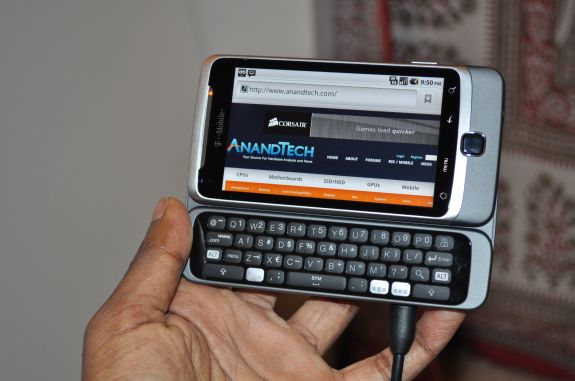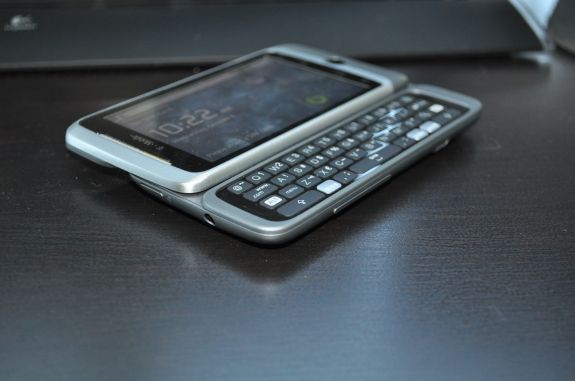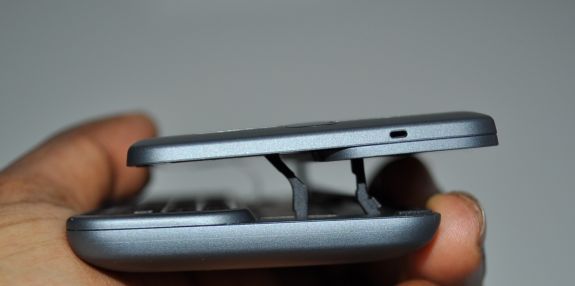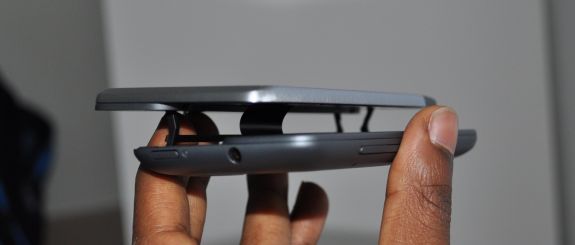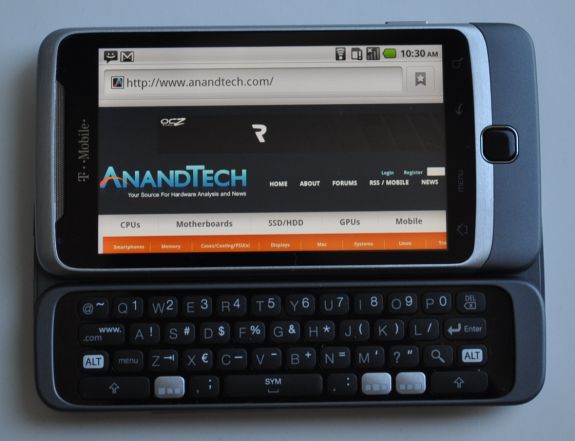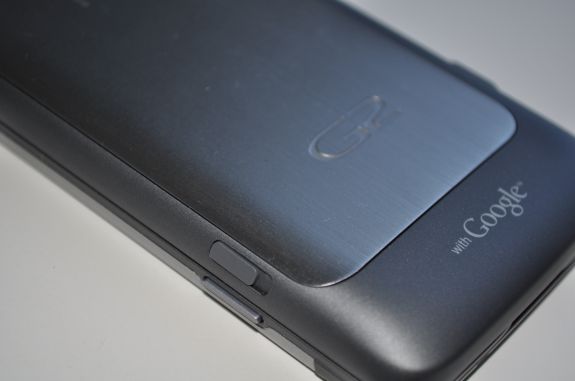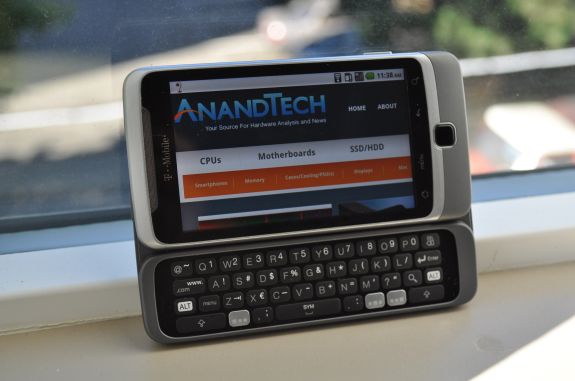
Original Link: https://www.anandtech.com/show/3967/the-tmobile-g2-preview
The T-Mobile G2 Preview
by Vivek Gowri on October 7, 2010 12:29 PM ESTSo, the son of G1 is now out and open for retail consumption, and it’s certainly an interesting device. This is one of the first high end GSM HTC Android devices in a while, so it’s been understandably hyped. The keyboard is another unique factor - this is HTC’s first Android device with a physical keyboard since the original G1, and the G2, along with the Samsung Epic 4G and Droid 2, is currently the one of the few high end Android devices with a physical keyboard.
| Physical Comparison | |||||||||
| Apple iPhone 4 | HTC EVO 4G | Samsung Epic 4G | Motorola Droid 2 | T-Mobile G2 | |||||
| Height | 115.2 mm (4.5") | 121.9 mm (4.8") | 124 mm (4.9") | 116.3 mm (4.6") | 119 mm (4.69") | ||||
| Width | 58.6 mm (2.31") | 66.0 mm (2.6") | 63.5 mm (2.5") | 60.5 mm (2.4") | 60.4 mm (2.38") | ||||
| Depth | 9.3 mm ( 0.37") | 12.7 mm (0.5") | 15.2 mm (0.6") | 13.7 mm (0.54") | 14.16 mm (0.56") | ||||
| Weight | 137 g (4.8 oz) | 170 g (6.0 oz) | 155 g (5.47 oz) | 169 g (5.9 oz) | 180 grams (6.35 oz) | ||||
| CPU | Apple A4 @ ~800 MHz | Qualcomm Snapdragon QSD8650 @ 1 GHz | Samsung Hummingbird @ 1 GHz | Texas Instruments OMAP 3630 @ 1 GHz | Qualcomm Snapdragon MSM7230 @ 800 MHz | ||||
| GPU | PowerVR SGX 535 | Adreno 200 | PowerVR SGX 540 | PowerVR SGX 530 | Adreno 205 | ||||
| RAM | 512MB LPDDR1 (?) | 512MB LPDDR1 | 512MB LPDDR1 | 512 MB LPDDR1 | 512 MB LPDDR1 | ||||
| NAND | 16GB or 32GB integrated | 8GB micro SD | 1 GB integrated, 16 GB microSD preinstalled | 8 GB integrated, preinstalled 8 GB microSD | 4 GB integrated, preinstalled 8 GB microSD | ||||
| Camera | 5MP with LED Flash + Front Facing Camera | 8MP with dual LED Flash + Front Facing Camera | 5 MP with LED Flash and autofocus | 5 MP with dual LED flash and autofocus | 5 MP with auto focus and LED flash | ||||
| Screen | 3.5" 640 x 960 IPS | 4.3" 480 x 800 | 4.0" 480 x 800 Super AMOLED | 3.7" 480 x 854 | 3.7" 480 x 800 Super LCD | ||||
| Battery | Integrated 5.254Whr | Removable 5.5Whr | Removable 5.55 Whr | Removable 5.2 Whr | Removable 4.81 Whr | ||||
The G2 comes with a Qualcomm MSM7230 SoC, an 800 MHz part based on the 2nd generation Snapdragon core. It’s now on a 45-nm manufacturing process (the original Snapdragon QSD8x50 parts are 65nm) and has an updated Adreno 205 GPU. Beyond the die-shrink, the CPU seems to be relatively unchanged compared to the first gen-Snapdragon, just running at an 800 MHz frequency. The lower clock speed is probably to keep power consumption and yield in check for Qualcomm's first 45nm SoC. The Adreno 205, on the other hand, seems to be a pretty big improvement over the previous generation Adreno 200. The 205 adds hardware acceleration for Flash, SVG vector graphics hardware acceleration, and significantly improves shader performance over the Adreno 200. Performance is expected to be far more competitive to the PowerVR SGX 530 and 540 than the Adreno 200 ever was. So even though it doesn’t break the magical 1GHz mark, the MSM7230 is still a very potent SoC, especially in a device that forgoes the burden of a custom UI layer on top of Android.
The MSM7230 in the G2 has support for 3GPP Release 7, which includes HSPA+ and Evolved EDGE support. The G2 supports HSDPA class 10 for a maximum theoretical downstream rate of 14.4 megabits/s, and HSUPA class 6 for a maximum theoretical upstream rate of 5.76 megabits/s. Qualcomm's MSM7x30 series SoC comes in another flavor - the MSM7630 - which packs HSPA+ support alongside CDMA voice and data.
Rounding out the other specs, we’ve got 512MB RAM (also part of the SoC), 4GB internal NAND with an 8GB microSD card preinstalled (more on this later), a 3.7” Super-LCD TFT display with an 800x480 resolution, a 5 megapixel camera with autofocus and an LED flash, 720p video recording at 30fps, and a removeable 4.81 Wh (1300 mAh) battery. Oh, and one of the weirdest hinges out there right now.
Before I actually get to the hinges, let me say that I’m a fan of HTC’s design and engineering team. They put out some of the most consistently well engineered mobile devices, and I’m struggling to remember the last time I was disappointed by the design or build quality of an HTC phone. Whether Windows Mobile or Android, HTC has generally been on top as far as build quality and design goes. Just look at the EVO, the HD2, the Incredible, the Nexus One, or the new Desire HD to see what I mean.
For the most part, the G2 is pretty great and up to the same HTC standard. The top half of the device is mostly constructed of an anodized aluminum, with the bottom edge being done in soft touch plastic. The same soft touch plastic is the primary material for the bottom half of the device, surrounding the keyboard and battery cover. The battery cover itself is rendered in brushed aluminum, with HTC and G2 logos etched in. The entire package is very solid as expected, and the level of attention to detail paid here is so high that there’s even a spring-loaded release switch for the battery door. This is stuff that normal handset makers don’t even dream about (Samsung, I’m looking straight at you. I was certain that the Fascinate’s back cover was going to snap the one time I tried to take it off). HTC's usual attention to design makes that “Z” hinge all the more perplexing.
Note the usage of the word hinge. Most landscape QWERTY devices use a slider - pretty simple stuff, just a set of rails on the back side of the screen and a set of protruding runners above the keyboard. You might find a spring attached to make the motion of the screen smoother and ensure the screen stays open or closed, though this depends on how much space there is (for example, the super-thin Droid and Droid 2 forgo the spring-loaded mechanism). Now the G1 had a funky, curved hinge that basically acted as a slider, since the motion was in the same plane as the screen (there was also an arced track/runner system on the left side of the device.) This time around though, HTC has one upped themselves and made that hinge act perpendicularly to the plane of the screen.
What this means is that instead of a curved slider like the G1, the G2’s screen actually travels in a semicircular arc in the process of “sliding” up, hoisting itself above the body and then coming back down to reveal the keyboard. It’s a pretty neat trick, seeing the screen a centimeter above the body, until it hits you - the only thing holding the screen and the body together at that point are three plastic posts that are about 1 mm^2 in cross sectional area, and an exposed ribbon cable. Oh God.
What makes this even more concerning is that HTC is having some early run quality control issues with the G2. Among the laundry list of common issues is that on some devices, the hinges are loose. For example, if one were to hold the phone upside down, the screen would fall open. As luck would have it, my unit was one of them. The looseness of the springs and the overall lifelessness of the mechanism probably is contributing to my paranoia about the hinges, but I have played with another G2 that did have properly working hinges and while the hinge did feel more robust, it certainly did not feel sturdy. I’d be interested to see how much fatigue testing HTC did before finalizing this hinge design for production, since the “pop hinge” (their term, not mine) seems like a pretty large Achilles’ heel for an otherwise excellent design.
One thing that’s pretty clear from HTC’s history is that they know how to make some pretty great smartphone keyboards. The Touch Pro 2, the original Tilt/TyTN II, the old school T-Mobile MDA, etc. - they all have excellent keyboards, and the G2 is no exception. In fact, the G2’s slide-out keyboard is pretty similar in both look and feel to the Touch Pro 2 keyboard, and that’s not a bad thing. The keyboard has very tactile feel, positive feedback for key presses, good spacing and layout, and even some shortcut keys that can be programmed to launch apps. Coming off the iPhone’s admittedly great virtual keyboard, I had zero trouble adjusting to the G2’s keyboard. Simply slide it open, start typing. That’s it. (I will say that the spacing is awful if you’re playing Quake 3, since you can’t use three separate fingers for the WASD keys, but that’s a different story and a problem with smartphone gaming in general.)
I felt obligated to at least try the virtual keyboard, and I’m happy to report that it works pretty well. It’s the default Froyo keyboard, and it doesn’t look or feel too different from most other virtual keyboards. It’s there, it works, but given the excellent physical keyboard, why bother?
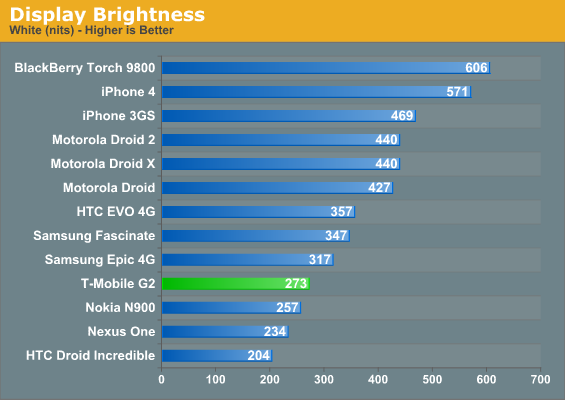
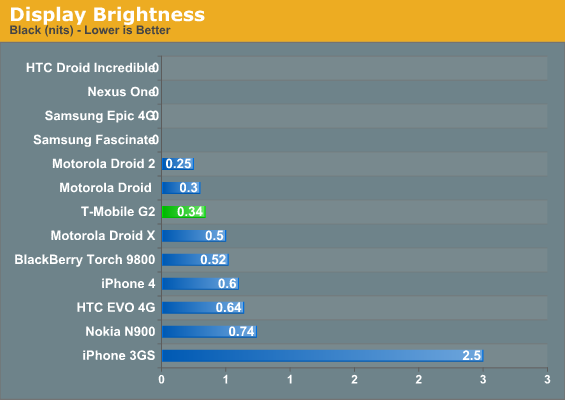
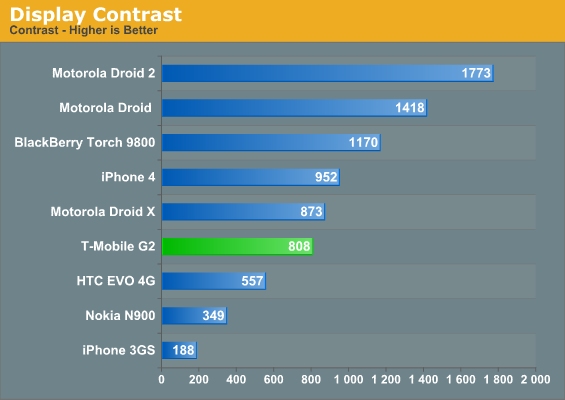
The display is the same resolution and size as those as on the Nexus One, Desire, and Incredible - 3.7” 800 x 480 - but is based on a different technology, Super LCD TFT. After the Samsung AMOLED shortages over the summer, HTC seems to have migrated over to the more commonly available Sony S-LCD panels on all of its 3.7” devices. I’m a fan of 3.7” screens, they strike a nice balance between the somewhat cramped 3.5” iPhone and the massive 4” Vibrants and 4.3” EVO’s of the world. The contrast ratio of just over 800 is significantly higher than HTC’s previous LCD screens (EVO 4G and HD2), and is fairly competitive with the iPhone 4 and Droid X, though the Droid and Droid 2 IPS panels are far, far higher. Overall the screen looks pretty good, though the max brightness of 273 nits is fairly low by superphone standards. You’ll get more in-depth analysis on the display in the full review, but I’ll leave you with this: unless you’re coming off an iPhone 4 or you enjoy blinding yourself every time you look at your cellphone screen, you shouldn’t have too many complaints with the G2’s screen.
The camera is a 5MP unit with autofocus and an LED flash, and it does fairly good work. I was pretty impressed by the flash, finding it better than even the EVO’s blinding flash. The dedicated camera button is nice to have, but even nicer than that are the camera settings. Like I mentioned, I’m mostly used to the iPhone, so having any kind of option is pretty new. You can change the white balance and exposure to suit the lighting conditions, turn the flash on and off, and mess with the focus and zoom (up to 2.0x). As you can see from the sample shots, the G2 is pretty solid by smartphone standards. It won’t wow you like some of the iPhone 4 HDR photos will, and it definitely will not come close to replacing a real camera, but for quick snaps, the G2’s camera should be serviceable enough when the pictures are scaled down to web size.
The video camera is pretty cool. It shoots video up to 720p and features a myriad of options, including flash on/off, the same white balance options as the still camera, and four filters (black and white, sepia, negative, and solarize). The mic is pretty bad, and it has some issues with high motion action and settings where the lighting changes rapidly, but it will replace a Flip video camera pretty easily.
Oh yes, and now we get to the real stuff. Benchmarks! Let’s start with the CPU benchmarks to see how the 800 MHz 2nd gen Snapdragon matches up with the older 1 GHz parts. All of them implement the same Scorpion architecture, except that the MSM7230 is manufactured on a 45nm process as opposed to 65nm for the QSD8x50. Simple colour coding scheme going on in the graphs here: red for the G2, green for the 1st generation Snapdragon phones, blue for anything running TI OMAP 3 underhood, gold for the Hummingbird Galaxy S devices, black for the iPhone 4, and purple for the Marvell PXA930-running BlackBerry Torch.
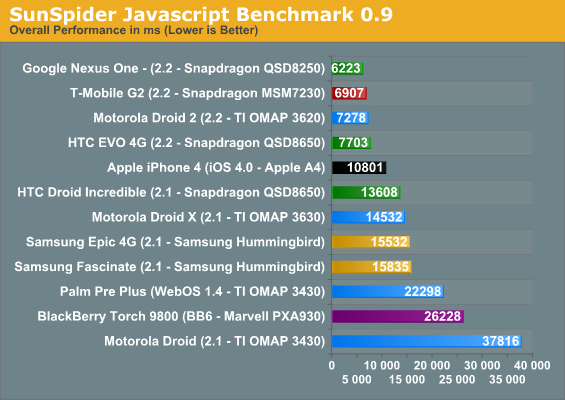
The SunSpider Javascript benchmark is very quick on the G2. While the Froyo Nexus One remains the fastest on most of these benchmarks, the G2 is definitely getting there, probably due to the untouched Android build it’s running. So even with a slower clockspeed, the G2 has a better score on the JS benchmark than the NinjaBlur-equipped Droid 2 and the Sense UI-equipped EVO 4G.
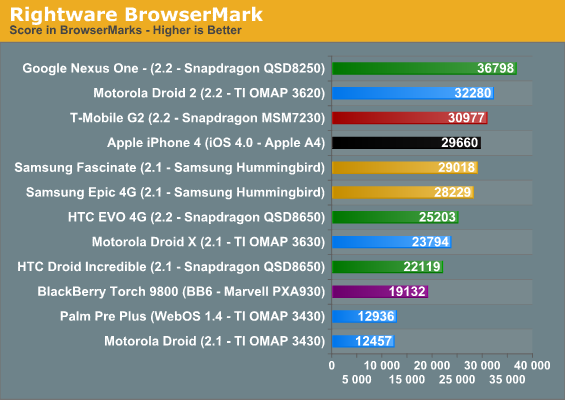
Rightware’s BrowserMark puts the G2 right between the Droid 2, the Fascinate, and the iPhone 4, and about 20% slower than the Nexus One. Given the 20% reduction in clock speed, this is pretty understandable.
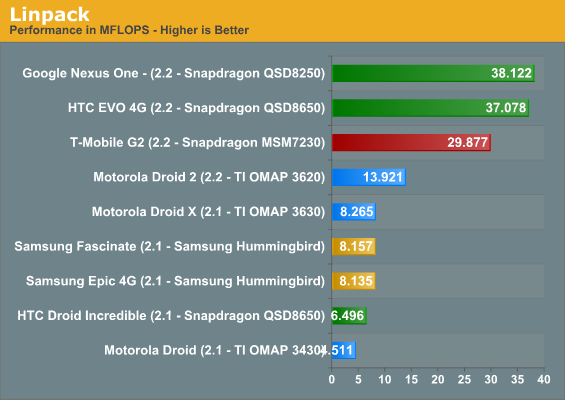
The G2’s Linpack score is about 25% lower than the Nexus One and EVO 4G, but significantly higher than the Droid 2’s score, potentially due to the higher throughput SIMD FP units in Qualcomm's CPU.
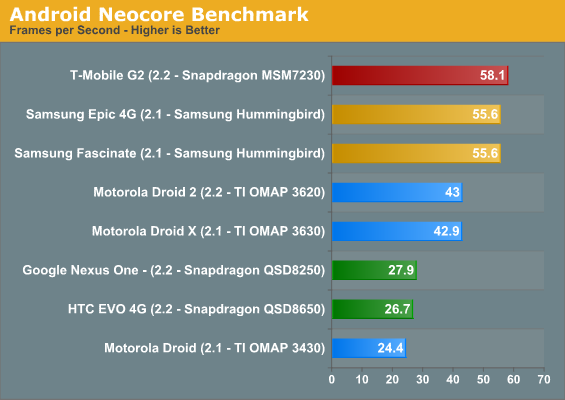
But the really interesting benchmarks are the graphics benchmarks. We’ll start with Neocore, which is Qualcomm’s benchmark to show off the capabilities of the Adreno GPU.
The score is quite good, at more than double the Nexus One’s. The benchmark is capped at roughly 60 fps which is why we see no real difference between the Adreno 205 and the PowerVR SGX 540. For a measurable performance difference we turn to our old favorite: Quake 3.
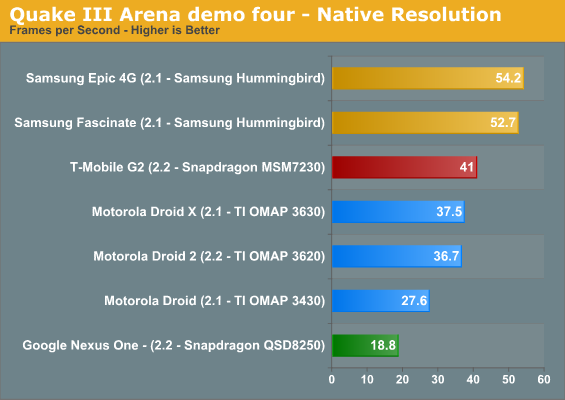
In a neutral gaming benchmark like the Quake III Arena demo, we can really get a feel for how fast Adreno 205 is. And though nothing on the market can touch the SGX 540, the Adreno 205 basically runs rings around the Adreno 200 in the EVO and Nexus One and even outpaces the SGX 530 in the Droid 2 and Droid X. So while the Adreno 205 isn’t world beating, it brings about a huge change by making the the 2nd generation Snapdragon SoC competitive as far as GPU performance goes. Qualcomm no longer comes with a GPU performance tradeoff.
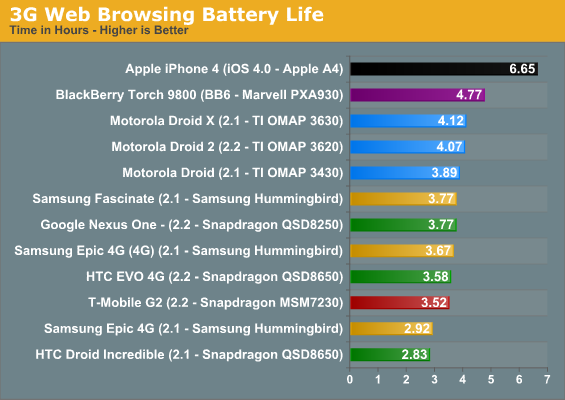
The G2 comes with a pretty small battery, a removable 4.81 Wh (1300 mAh) Li-ion affair that can be easily accessed and replaced. The Nexus One came with a 5.18 Wh battery, the Droid 2 had 5.2 Wh capacity on tap, the Droid X had a 5.6 Wh unit, and the EVO used a 5.5 Wh battery. So naturally, with a lower capacity battery, the G2 comes with less battery runtime too. Thus far we’ve only had the time to run the 3G web browsing battery life test, and the G2 is way down at the very bottom of our charts, matching the Palm Pre Plus in battery life (which has a 1150 mAh battery). It’s not too bad, it’s on par with the Nexus One for minutes-per-Wh efficiency, but 3.5 hours of 3G web browsing is still not very good.
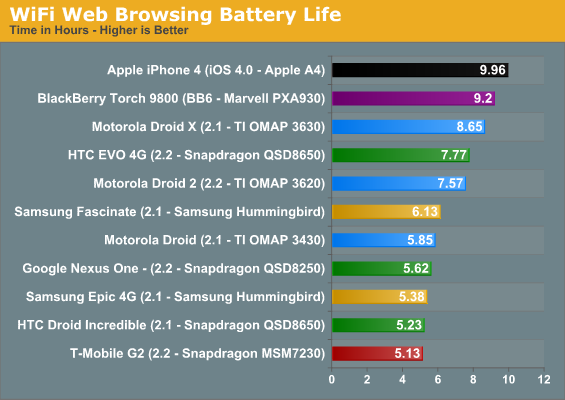
Update: We're adding battery life tests as we go, so here's the WiFi browsing test. Again, it's almost at the bottom, again it's about on par with the Nexus One on an efficiency level. It's a small battery, so when compared to phones that have 10-20% more battery capacity, it does look quite poor. What does seem to be consistent though is that the OMAP 3 phones are more power efficient, even on a per-Wh basis.
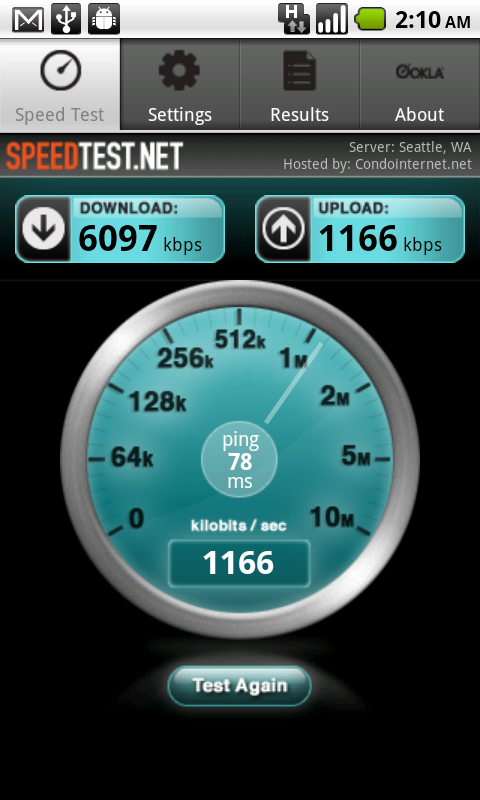
But given the 3G speeds the G2 is pulling, maybe we should give it a pass. T-Mobile's HSPA+ network is FAST, even in areas of Seattle that have rather poor signal coverage. On average, I'm pulling around 5.5 Mbps downstream and anywhere between 1 and 1.5 Mbps upstream. Interestingly, this is signifcantly faster than the speeds I saw out of Sprint's WiMAX 4G network on the EVO when I had it in June. While I can't vouch for areas that don't have T-Mobile's HSPA+ network enabled yet, the areas that do should see the G2 fly. It's T-Mobile's first HSPA+ device, so it should be able to utilise the full potential of the faster network.
HTC has been having some interesting problems with the G2. For an HTC handset, it seems like there are a lot of minor issues popping up all over the place. I already mentioned the loose hinges issue, but there’s also an issue with the amount of memory the phone ships with. The G2 is supposed to have 4GB of NAND built in, whereas the Desire Z has 2GB of flash memory. More than a few G2’s (including mine) have shipped with 2GB onboard as opposed to the 4GB that it should be. It sounds like a pretty simple assembly line mixup on HTC’s part, but it’s still odd to see so many production issues with an HTC device, regardless of how new it is. I’m supposed to be exchanging mine for a different unit sometime soon, but we’ll see how T-Mobile decides to handle this one.
Edit: A bit of Googling brings me to this thread on the xda-developers forum, which basically says that the G2 ships with a 4GB NAND chip onboard, but the remainder of the memory is not recognized. How T-Mobile/HTC plan to fix this issue still remains to be seen.
Overall though, the G2 has the potential to impress. Great design, a great keyboard, good screen, solid camera/camcorder and good performance. The hinge and battery life are two significant issues that prevent the phone from being great. I suspect T-Mobile's sudden stop of preorders for the G2 has more to do with correcting the build quality issues and less with actually fulfilling demand. There's unfortunately no way around the battery life, but we'll reserve a full conclusion for when we have our entire suite of battery tests complete.
The manufacturing issues aside, G2 seems to live up to the immense hype it had before launch, and T-Mobile seems to have a winner on their hands. Most people who got G1 contracts early on should be set to upgrade right about now, making the G2 doubly attractive to those people.
For a number of reasons, the G2 strikes a unique place in the market, one that has been sorely missed since the passing of the original G1. As the first top tier GSM Android device with a keyboard (since the G1), the first top tier HTC GSM Android device (since the Nexus One), and the only Android device on any network that’s running a completely stock version of Android, the G2 is going to get a lot of fans really quickly. Let's hope T-Mobile can address the hinge issues quickly enough to avoid disappointing those eager fans.

